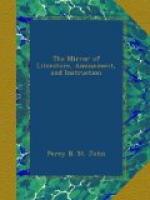This mountain is situate near the end of a ridge of mountains, leading from Stainmore or Stonemore, about sixteen miles in length. It descends gradually from Brough to the Grained Tree, the former boundary mark dividing Yorkshire from Westmoreland. Passing over several mountains, we arrive at Dufton Fell, of the same ridge.
At the foot of this fell there is a curious little petrifying spring, which turns moss, or any other porous matter which may fall within its vortex, or the steams and vapours arising therefrom, into hard stone, insomuch that upon the mouth of it there is a considerable hill of such petrifaction.
Cross Fell is the highest mountain of the whole ridge, and is bounded by a small rivulet stocked with trouts. This was formerly called Fiends’ Fell, from evil spirits, which are said to have haunted its summit, “and to have continued their haunts and nocturnal vagaries upon it, until Saint Austin erected a cross and altar, whereon he offered the holy eucharist, by which he countercharmed those hellish fiends, and broke their haunts.”—Robinson’s History of Cumberland and Westmoreland, 1709.
Since the saint expelled the fiends, the mountain (it appears) has taken the name of Cross Fell, in commemoration of the event.
There are now existent seven stones lying in a careless condition on the top of this mountain, as if destroyed by the hand of time. The stones, it is supposed, are the remains of the cross and altar. One stone is considerably higher than the rest, and they are overgrown with moss.
I have heard many of the traditions which are very current, but all such hyperboles, that were I to give one, the reader would be convulsed with laughter. I trust, sir, if you have any travellers among your numerous readers, they will give this a further investigation, and I (as well as yourself, doubtless) shall be happy to learn the result.
Your’s. &c.
W.H.H.
* * * * *
SALMON KIPPERING, IN DUMBARTONSHIRE.
(For the Mirror.)
Salmon are caught in less or greater abundance in all the rivers of this county. The salmon-fisheries of Lochlomond and the Leven are of considerable value. In several parts of the county salmon are cured in a peculiar manner, called kippering; and throughout Scotland kippered salmon is a favourite dish. It is practised here in the following manner:—All the blood is taken from the fish immediately after it is killed; this is done by cutting the gills. It is then cut up the back on each side the bone, or chine, as it is commonly called. The bone is taken out, but the tail, with two or three inches of the bone, is left; the head is cut off; all the entrails are taken out, but the skin of the belly is left uncut; the fish is then laid, with the skin undermost, on a board, and is well rubbed and covered over with a




